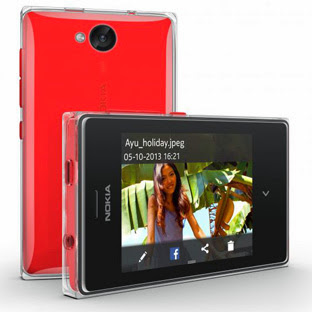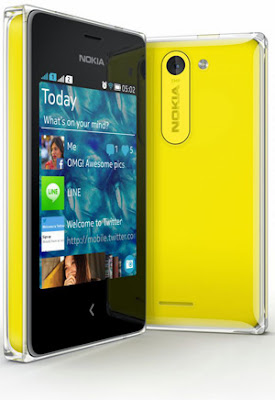
These amazing new phones feature a stunning new layered design approach, offer the latest version of the new Asha Platform debuted on the Nokia Asha 501 earlier this year, and have updated specifications across the board.
Seeing the light
A new hardware design combines two finely-crafted layers of polycarbonate: a vibrantly coloured core, beneath a strong transparent layer. The combination captures and reflects light and colour beautifully, without adding to the size or weight.
Life in the Fastlane
The Fastlane is the key to the new Asha experience. It’s a swipeable record of your past, present and future. It offers quick access, notifications and reminders for everything that’s important to you. From this second home screen, you can use a swipe gesture to simply take actions, whether that’s replying to a message, commenting on a friend’s photo or getting to your meeting on time.
New to the platform are an improved imaging experience, with much faster, swipe access to the camera, the gallery and social sharing, supported by improved hardware. It’s one tap to share a photo, while a single swipe takes you between the viewfinder and the gallery.

There’s also a more social and customizable experience on Fastlane, where you can now see counters for updates from Facebook and Twitter, and control what sort of content can appear on your screen. If you have privacy concerns about a certain app being able to write to Fastlane, you can block it from the settings.
Continued app support for the platform is also celebrated today, with the launch of the enormously popular WhatsApp for new Asha Platform devices, including the Asha 501.
We also welcome new imaging apps like Picfeed, Pictag and Photofunia. With these, improved camera specs and improvements in usability, picture fun is definitely on the agenda with this new family.
Owners of the first Asha Platform device, the Asha 501, aren’t left out: they will receive the new features through a software update. All new Asha 501s shipped from the factory will also come with the new software.
Three of a kind
While all three of these new phones come with the same software and stunning hardware design, the three offer hardware specifications that scale upwards by model number and price.
How does that play out? The Asha 500 offers a 2.8-inch screen, a 2-megapixel camera and 2G telephony. Next up is the Asha 502 that comes with a 3-inch screen, a 5-megapixel with flash, and 2G again. At the top of the current family is the Asha 503: this one comes with 3-inch screen made from curved Gorilla Glass, a 5-megapixel camera with flash, and 3.5G speeds. The Asha 500 and 503 come in single- and dual-SIM variants, with our Easy Swap technology on dual-SIM, which lets you swap cards without restarting the phone.
The new Asha 500, 502 and 503 will available from quarter four, with sales beginning in the Asia-Pacific market. Before any local taxes or operator subsidies, the Nokia Asha 500 will retail at around USD 69; the Asha 502 at around USD 89 and the Asha 503 at about USD 99.

Specs Comparison of Nokia Asha 500, 502 and 503
| Asha 500 (single SIM and Dual SIM) | Asha 502 (Dual SIM) | Asha 503 (single SIM and Dual SIM) | |
| Network | GSM 900/1800, 850/900/1800/1900 | GSM 900/1800 | EGSM 850/900/1800/1900/2100;WCDMA |
| Size & weight | 100.3 x 58.1 x 12.8mm; 101.3g | 99.55 x 59.50 x 11.10mm; 100g | 102.55 x 60.55 x 12.70mm; 110.15g |
| Screen size / type | QVGA 2.8-inch capacitive | QVGA 3-inch capacitive | QVGA 3-inch capacitive, curved Gorilla Glass |
| Camera | 2-megapixel | 5-megapixel with LED flash | 5-megapixel with flash LED |
| Storage | 64MB RAM; up to 32GB micro SD card support | 64MB RAM; up to 32GB micro SD card support | 128MB RAM; up to 32GB micro SD card support |
| Connectivity | Bluetooth 3.0 with SLAM; AV jack; WLAN; Micro-USB | Bluetooth 3.0 with SLAM; AV jack; WLAN; Micro-USB | Bluetooth 3.0 with SLAM; AV jack; WLAN; Micro-USB |
| Battery | Standby: up to 35 days; Talk time: up to 14 hours | Standby: up to 24 days; Talk time: up to 13.7 hours | Standby: up to 35 days; Talk time: up to 12 hours |
